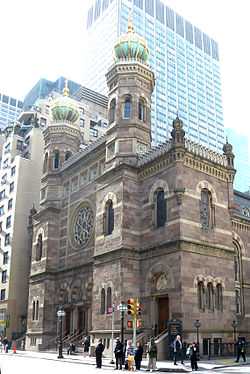Henry Fernbach

Interior of Central Synagogue

New York Mutual Life Insurance Company Building, top three floors added later designed by Philip Roos
Henry Fernbach was an architect in New York City. Born in Breslau in Germany, he immigrated to the U.S. in 1848[1] or in 1855.[2] He was Prussian of Jewish descent.[2] He trained at the Bauakademie in Berlin.[3] He served as Treasurer of the United Association of American Architect.[1] Alfred Zucker and Theodore de Lemos partnered with him. He is known for his synagogue designs, mainly in the Moorish Revival architecture style.[2] Paul J. Pelz worked as a chief draftsman for him. He designed the German Savings Bank with Edward H. Kendall.
Works
- Stern Brothers Department Store (Stern's)
- Temple Emanu-El assisting Leopold Eidlitz (for Congregation Emanu-El of New York) Building no longer in existence.[4][5]
- Greene Street Building
- Central Synagogue
- Harmonie Club
- New York Mutual Life Insurance Company Building, Philadelphia, top three floors added later were designed by Philip Roos
- Salem Field Cemetery entrance (1867)[3]
- 113, 115 Spring Streets, lofts with Tuscan columns and cast iron fronts[6]
- SoHo Hotel at 101-111 Greene Street (not the new buildings 101 and 107-11 by Joseph Pell Lombardi)[6]
- 67, 69, 71, 75, 77, 81 Greene Street (1873)[6]
- First Jewish Orphan Asylum[1] (Hebrew Orphan Asylum of New York) (1863) at East 77th Street near Third Avenue[7]
See also
References
- ↑ 1.0 1.1 1.2 Passikoff, Alexander G. (September 8, 2011). A Façade of Buildings: A Collection of Architectural Styles, Architects, and Their Buildings That Make Up the Face of New York pp. 82–83
- ↑ 2.0 2.1 2.2 Henry Fernbach New York Achitecture
- ↑ 3.0 3.1 Bedoire, Fredric. The Jewish Contribution to Modern Architecture, 1830-1930 pp. 425–426.
- ↑ Temple Emanu-El
- ↑ Temple Emanu-El image NYC-architecture.com
- ↑ 6.0 6.1 6.2 White, Norval; Willensky, Elliot; Leadon, Fran. AIA Guide to New York City.
- ↑ The New Jewish Orphan Asylum October 29, 1863
